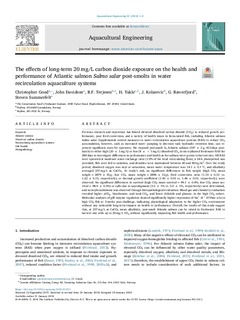| dc.description.abstract | Previous research and experience has linked elevated dissolved carbon dioxide (CO2) to reduced growth performance, poor feed conversion, and a variety of health issues in farm-raised fish, including Atlantic salmon Salmo salar. Supplemental control measures in water recirculation aquaculture systems (RAS) to reduce CO2 accumulation, however, such as increased water pumping to decrease tank hydraulic retention time, can represent significant costs for operators. We exposed post-smolt S0 Atlantic salmon (197 ± 2 g, 423 days post-hatch) to either high (20 ± 1 mg/L) or low (8 ± <1 mg/L) dissolved CO2 in six replicated freshwater RAS for 384 days to investigate differences in performance and health as the salmon were grown to harvest size. All RAS were operated at moderate water exchange rates (1.0% of the total recirculating flow), a 24-h photoperiod was provided, fish were fed to satiation, and densities were maintained between 40 and 80 kg/m3. Over the study period, dissolved oxygen was kept at saturation, mean water temperature was 14.1 ± 0.1 °C, and alkalinity averaged 237 mg/L as CaCO3. At study’s end, no significant differences in fish weight (high CO2 mean weight = 2879 ± 35 g; low CO2 mean weight = 2896 ± 12 g), feed conversion ratio (1.14 ± 0.12 vs. 1.22 ± 0.13, respectively), or thermal growth coefficient (1.45 ± 0.01 vs. 1.46 ± 0.01, respectively), were observed. No significant differences in survival (high CO2 mean survival = 99.1 ± 0.4%; low CO2 mean survival = 98.9 ± 0.3%) or culls due to saprolegniasis (3.5 ± 1% vs. 3.0 ± 1%, respectively) were determined, and no nephrocalcinosis was observed through histopathological evaluation. Blood gas and chemistry evaluation revealed higher pCO2, bicarbonate, and total CO2, and lower chloride and glucose, in the high CO2 cohort. Molecular analyses of gill enzyme regulation showed significantly higher expression of Na+/K+ ATPase α1a in high CO2 fish at 3-weeks post-challenge, indicating physiological adaptation to the higher CO2 environment without any noticeable long-term impacts on health or performance. Overall, the results of this study suggest that, at 237 mg/L as CaCO3 mean alkalinity, post-smolt Atlantic salmon can be raised in freshwater RAS to harvest size with up to 20 mg/L CO2 without significantly impacting fish health and performance. | |
